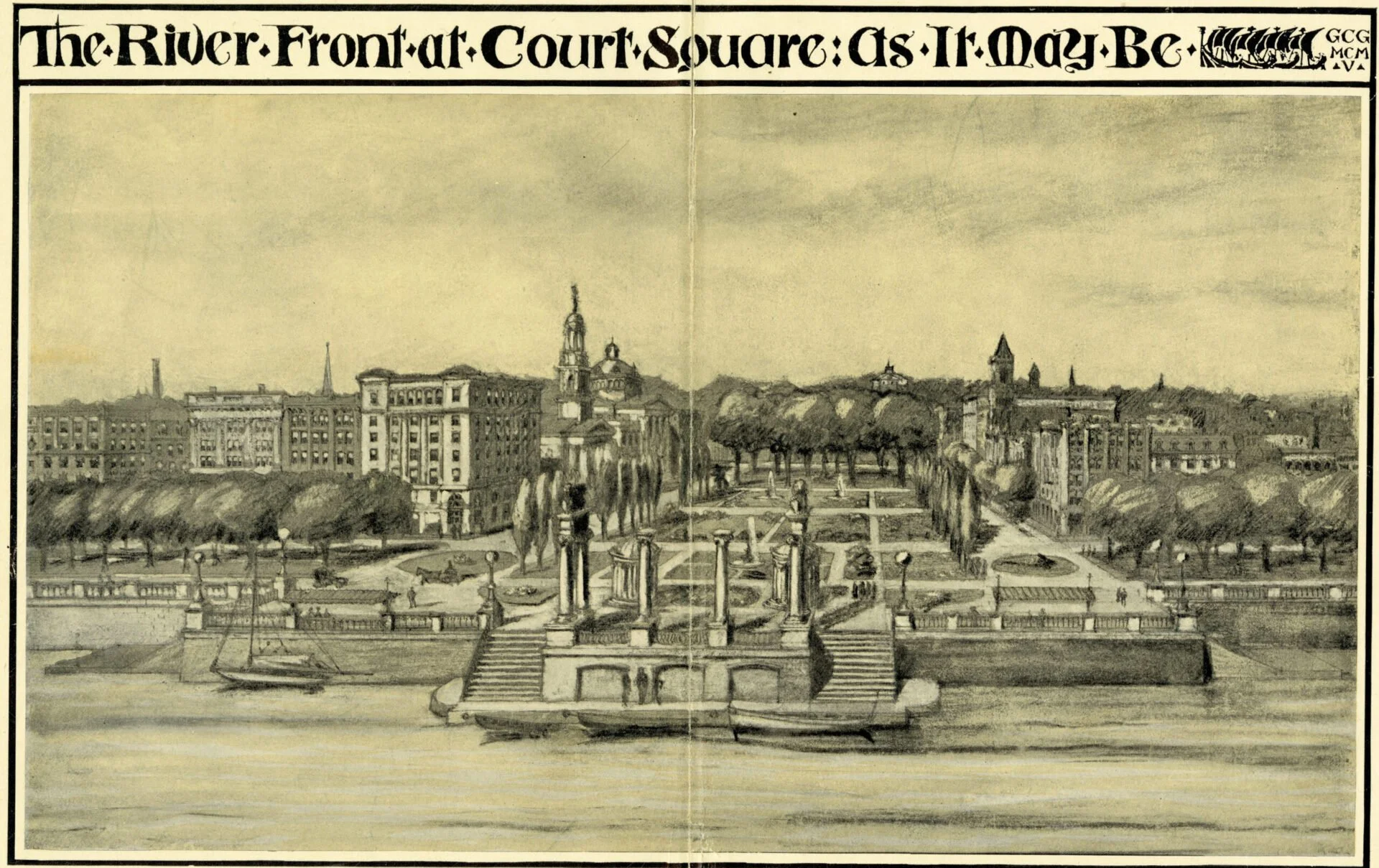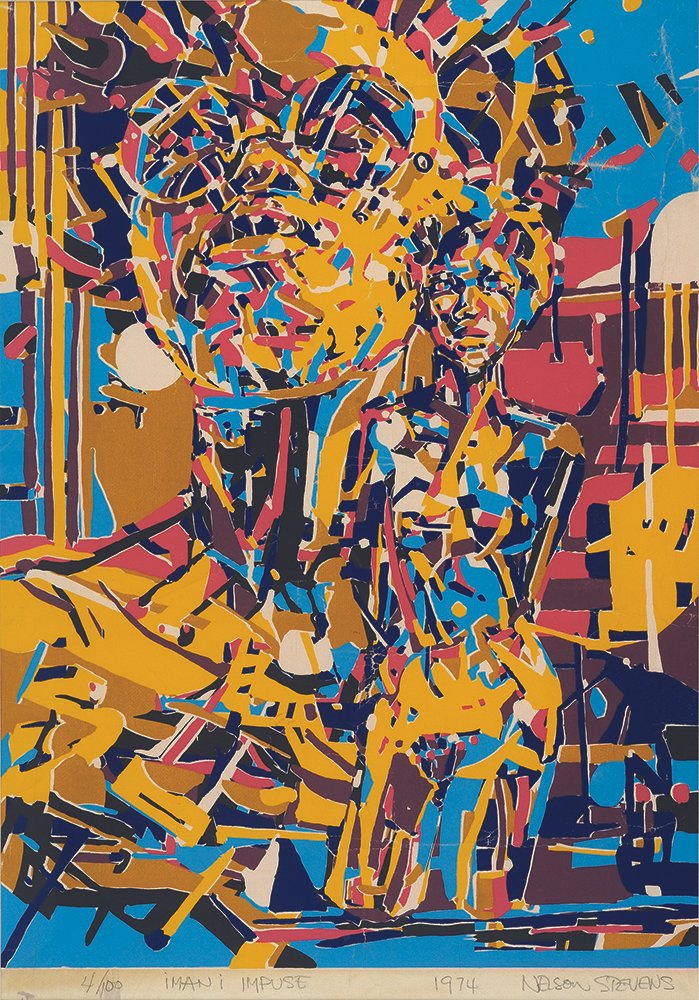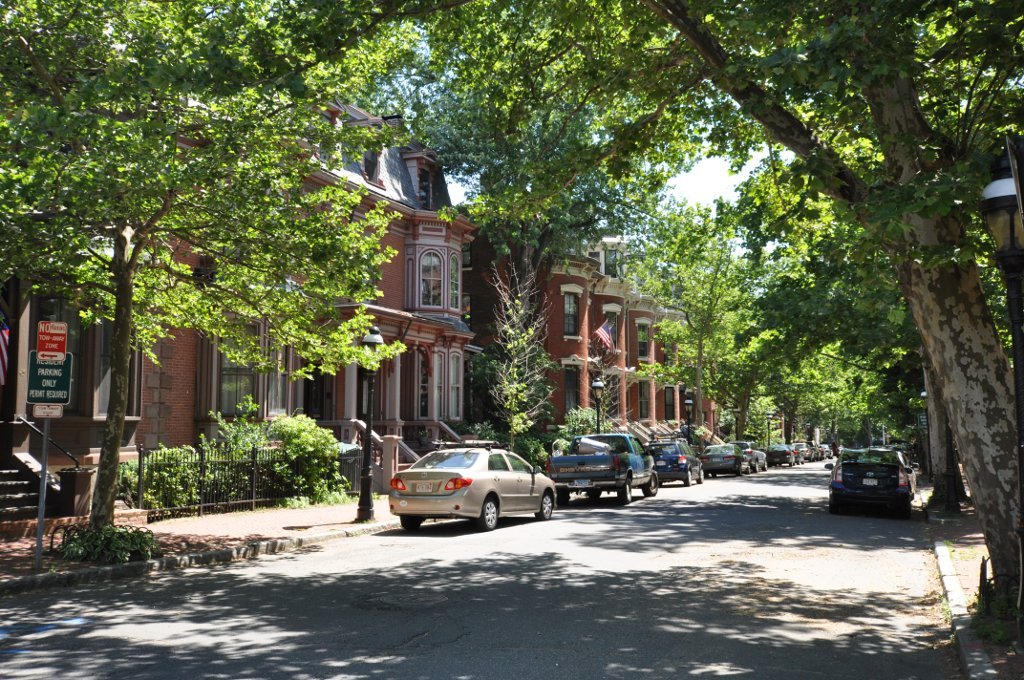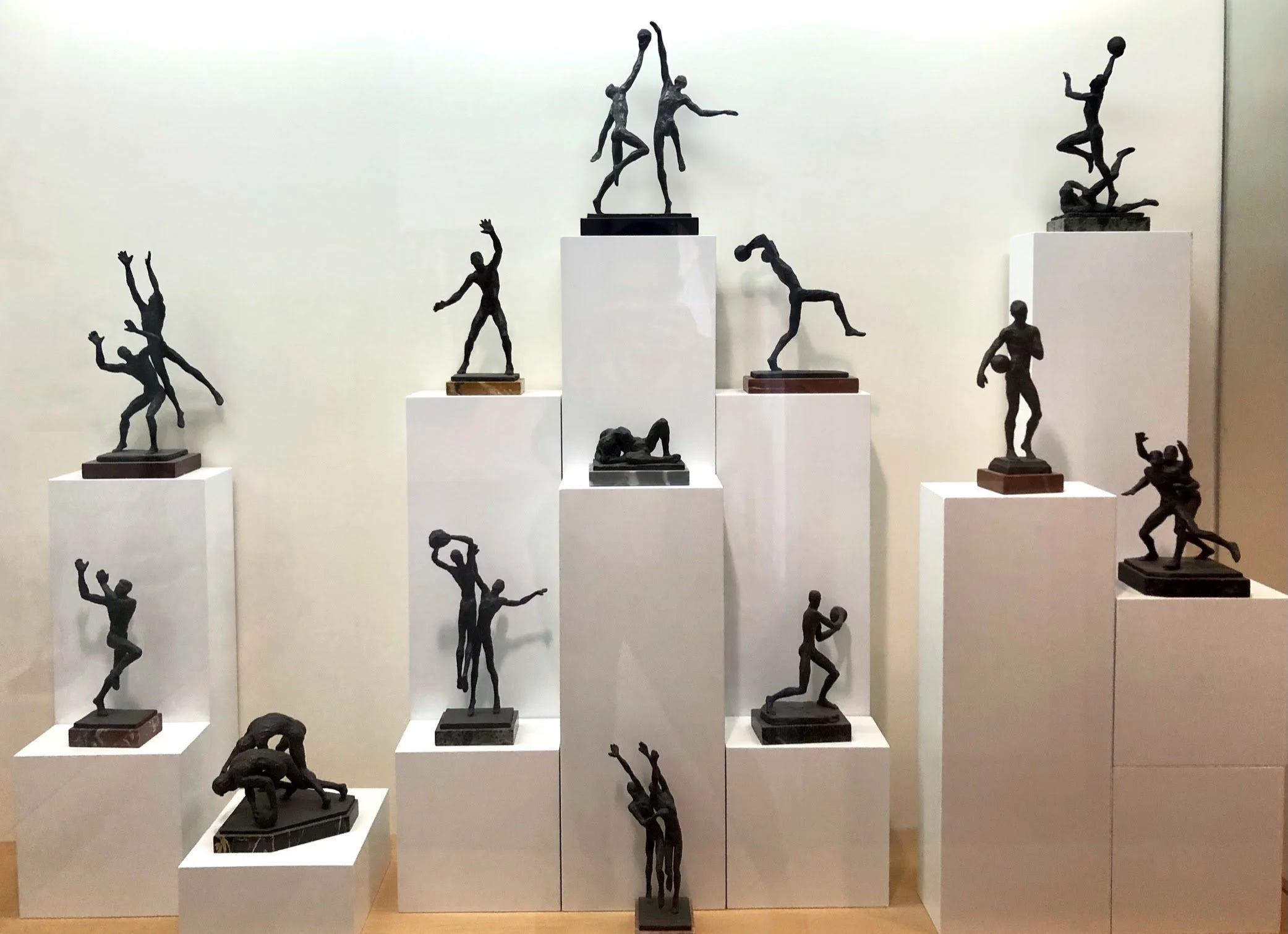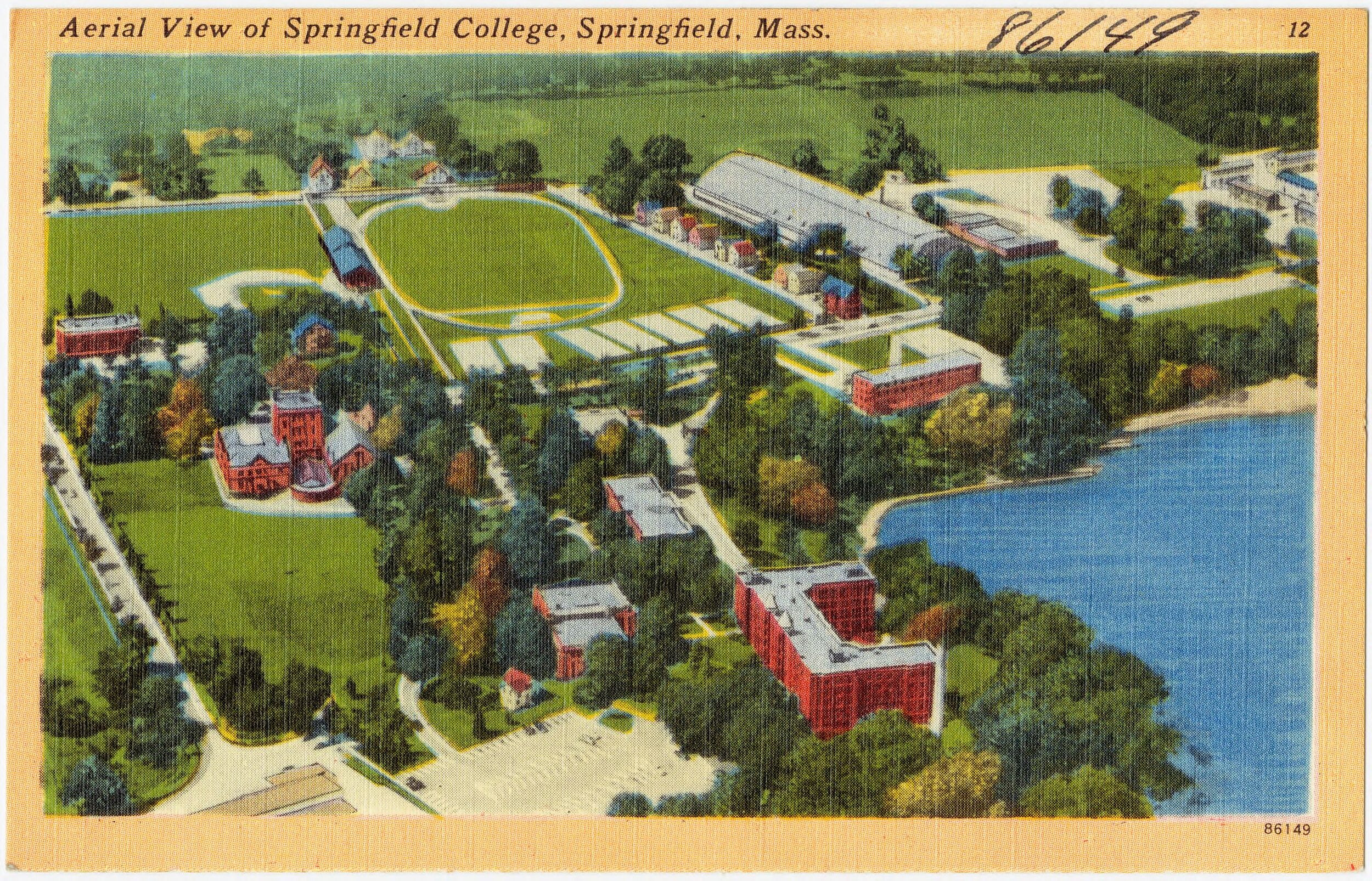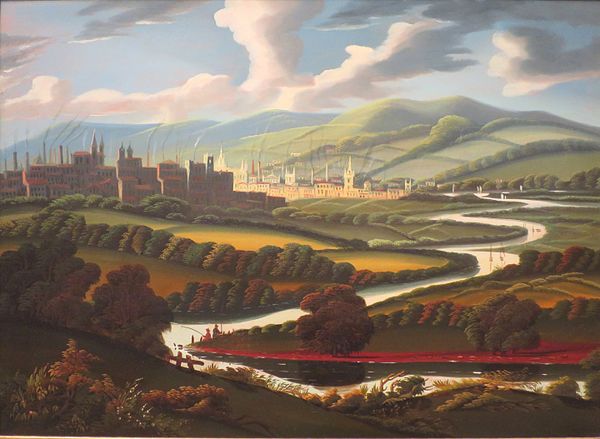
Designing Springfield's downtown through the years
From the “Designing Downtown” show at the Wood Museum of Springfield (Mass.) History through March 30.
The museum explains:
“Explore the history of downtown Springfield through centuries of plans that were never brought to fruition. Maps, drawings, blueprints, and more documents created by local citizens and nationally known city planners offer a glimpse into Springfield as it could have been and, at the same time, how the modern city came to be.
“Visitors can recreate a 1908 vote on the design of City Hall and can explore renowned landscape designer Frederick Law Olmsted Jr.’s plan for a ‘Washington Mall’-inspired design for Court Square in expanded detail using touchscreen technology. Visitors will leave the exhibition with a new appreciation for the shape of Springfield, with an eye towards its future development as the city continues to expand.’’
Mural goes multisensory
Mural by Sante Graziani at the D’Amour Museum of Fine Arts, in Springfield, Mass.
The museum explains:
“Sante Graziani submitted the winning design to a mural competition hosted by the Springfield Museums. The artist’s mural, which was painted in 1947 and celebrates Springfield’s vibrant artistic community, remains on view in its original location at the D’Amour Museum of Fine Arts. In celebration of the 75th anniversary of Graziani’s mural, the Springfield Museums invite visitors to explore a custom-made tactile reproduction of the artwork. This multisensory interactive includes buttons and sensors that activate audio recordings and encourage visitors to engage with the mural through touch and sound.’’
Inherited from Bollywood
From “Artifice,’’ new paintings by Springfield, Mass., artist Priya N. Green, at the D’Amour Museum of Fine Arts, Springfield, through Dec. 31
She says that her “layered oil paintings explore ideas of reality and perception through the pervasive images found in the news. Green’s work forms a response to the phenomenological impact of absorbing information and seeking truth through the screen. She uses the materiality of paint to address the veracity of the photographic images that have penetrated the twenty-first century psyche. As the granddaughter of a Bollywood screenwriter, Green believes her fascination with images is an inherited trait. By extracting and manipulating these images through paint, she forms an emotional connection to these events that are otherwise intangibly experienced through a screen.’’
Multi-faceted rapping
Work from the show “Nelson Stevens: Color Rapping,’’ at the D’Amour Museum of Fine Arts, Springfield, Mass., through Sept. 3.
The museum says:
“Nelson Stevens (American, 1938-2022), an artist and educator, is renowned for creating powerful, rhythmic compositions that celebrate Black life and reveal his technical mastery of the figure.’’
“Stevens lived in Springfield. In the early 1970s, {where} he initiated a groundbreaking public art project that resulted in the creation of over 30 murals throughout the city. Like Stevens’s colorful paintings, the murals promoted Black empowerment and brought the pride and activism associated with the Black Arts Movement to western Massachusetts. Fifty years later, his message, artwork, and influence continue to be celebrated locally and nationally.”
“I create from the rhythmic color-rappin-life-style of Black folk. I believe that art can breathe life, and life is what we are about.’’
— Nelson Stevens
Ripen, then leave
Victorian-era row houses in Springfield, built in the city’s industrial heyday.
“Springfield, Massachusetts, is a place to be from. Talented people ripen in Springfield, then move away to larger cities to make their fortune.’’ (Like Theodor Geisel, the Springfield native later known as Dr. Seuss.)
— James C. O’Connell, in Pioneer Valley Reader (1995)
Indoor sport
Collection of basketball players, by Walker Hancock (1901-1998), 1960s, bronze. in the Cape Ann Museum, Gloucester, Mass.
Here’s James Naismith, who invented basketball in 1891 at the International YMCA Training School, in Springfield, Mass.
Donald Brown/Sherry Earle: Springfield College’s Legacy Alumni of Color
Old postcard
From The New England Journal of Higher Education, a service of The New England Board of Higher Education (nebhe.org)
BOSTON
In 1966, Jimmy Ruffin sang “What Becomes of the Brokenhearted?” This song resonates with us and many of our colleagues whose hearts were broken 55 years ago at our alma mater, Springfield College …
Virtually every Black student at the college in those days felt unwelcomed. Not only was there a dearth of Black faculty, but there were also virtually no administrators of color and no support services to address the needs of the dozen Black students on campus.
This was a time when Muhammad Ali refused the military draft. The Rev. Dr. Martin Luther King, Jr. was assassinated. John Carlos and Tommy Smith raised their fists in a Black Power salute at the 1968 Olympics. Students of color throughout the country were demonstrating for equality and fair treatment on their campuses.
These epochal events were not lost on Black students at Springfield College. In 1969, we took over the administration building and the following year occupied a dormitory. As a result, virtually all of those who participated in the dormitory takeover were suspended from the college. Brokenhearted, most of them walked away from Springfield College not to be heard from again for 50 years.
A half-century later, I observed the racial tumult of 2020 and reflected on our experience in the 1960s. For it was then that I had an idea. I would check with a few of my sisters and brothers with whom I had shared this undergraduate experience. I began making calls asking if they would reach out to others to see if there was any interest in a Zoom conference call to generally catch up on their life journeys and to ask them how they felt about today’s Springfield College. To my surprise, everyone who was called wanted to meet. I was ecstatic.
Through the process of making calls about a possible reconnect, I and others learned that while Springfield College now has more than 300 Black and Brown full-time undergraduates, these students still have issues that demand attention from the college. These are issues that have frustrated Black students dating back to the days when there were only a handful of Black students, and virtually no Brown students at all on campus. So, in March 2020, my brother and sister alumni began meeting with current leaders of BIPOC (Black, Indigenous, People of Color) students. We decided that to support BIPOC students and influence change at the college, we needed to create a formal group. Hence, the Legacy Alumni of Color of Springfield College was born.
Out of a burning concern to ensure a better experience for Springfield College BIPOC students, our group decided to set up five committees focused on: Mentoring, Public Safety/Student Relations, Coaching/Faculty, Day of Diversity, and Distinguished Alumni. Each committee developed a plan of action in their respective areas. Based on committee input, the Legacy Alumni, in turn, crafted an 18-page report entitled: “Legacy Alumni of Color: A Blueprint for Change” and sent it to the president of the college, Mary-Beth A. Cooper. Responses to all of our recommendations were soon forthcoming. Overwhelmingly, the Legacy Alumni were pleased with the college’s responses to our recommendations.
Listed below are just a few of the recommendations made by the Legacy Alumni of Color.
1. Increase ethnic diversity on the senior leadership team to set an example for the college.
2. Build a pipeline to develop BIPOC students for positions in administration, teaching and coaching.
A. Begin with programs for middle school and high school BIPOC students.
B. Conduct a college-sponsored summer institute to develop BIPOC candidates.
C. Continue the mentorship work begun by the Alumni Office.
D. Continue work with NCAA initiatives on diversity and inclusion.
• Have coaches review the 2020 NCAA Inclusion Summer Series and past Equity and Inclusion Forums.
• Have the college sign the Eddie Robinson Rule to ensure that departments of athletics pledge to “interview at least one, preferably, more than one, qualified racial and ethnic minority candidate” for open head coaching jobs.
• Continue participation in the NCAA Ethnic Minority and Women’s Internship program.
• Participate in upcoming NCAA programs to advance racial equity.
3. Improve recruitment of BIPOC students by increasing the diversity of staff in the Office of Undergraduate Admissions.
4. Increase staff and provide adequate funding for the Office of Multicultural Affairs in order to continue the important work of the office to create an inclusive campus, support BIPOC students and address issues of social justice.
5. Include the Office of Multicultural Affairs on tours when prospective students visit the campus.
6. Ensure that members of underrepresented groups are included on all hiring committees.
7. Hire a person of BIPOC descent in the Counseling Center.
8. Hire a person of BIPOC descent in the Office of Spiritual Life.
9. Continue to archive oral histories of BIPOC student experiences at Springfield College.
10. Strengthen ties with the off-campus community by sponsoring and hosting activities and events.
A. Support community service currently conducted by student-run organization such as Women of Power’s supply drive for the YWCA.
B. Increase ties to Springfield’s very active Black religious community.
C. Recruit BIPOC students from Springfield’s middle and high school for on-campus events.
D. Continue to send college staff to provide technical assistance to off-campus community groups.
11. Conduct an annual climate-of-life survey to learn what the experience has been for BIPOC students.
12. Require all entering students take the newly created course in ethnic studies beginning in the fall 2021.
13. Increase funding for existing student-run associations that support BIPOC students. Provide seed money to launch new student-generated associations.
A. Adequately fund the Men of Excellence program to empower men through development of leadership skill, pride and humility
B. Support the Student Society for Bridging Diversity, originally created as the African American Club in the 1980s, to recognize and accept all members of the human race.
C. Support women on campus and in the community through Women of Power group.
14. Make A Day to Confront Racism an annual event to address power, privilege and prejudice. Allocate sufficient funds to engage a speaker with standing equal to that of Ibram X. Kendi, this year’s speaker.
15. Continue the work of the Committee on Public Safety to reduce tension and misunderstanding in interactions between BIPOC students and Public Safety Staff (PSS).
A. Provide name badges for all PSS.
B. Conduct twice yearly dialog groups between BIPOC students and PSS.
C. Complete evaluation sheets following these dialogs to set the agenda for further work.
D. Continue anti-bias training for PPS staff.
16. Prominently display recognition of distinguished BIPOC alumni.
17. Ensure continued progress by issuing a twice annual scorecard on measurable progress made on these and other recommendations emanating from the “Legacy Alumni of Color: A Blueprint for Action” report and continuing feedback.
We believe that the Legacy Alumni of Color has done something at Springfield College that no other school in the nation has done. We returned to our alma mater to help fashion a welcoming, inclusive environment for students of all racial and ethnic backgrounds.
So, that’s what became of these brokenhearted. Not a bad outcome, not a bad start.
Donald Brown is the former chair of the Legacy Alumni of Color of Springfield College and the president & CEO of Brown and Associates Education and Diversity Consulting and former director of the Office of AHANA Student Programs at Boston College. Sherry Earle is a member of the Legacy Alumni of Color of Springfield College and a teacher of gifted children in Newtown, Conn.
Editor’s Note: Donald Brown wrote “What Really Makes a Student Qualified for College? How BC Promotes Academic Success for AHANA Students” for the Spring 2002 edition of NEJHE‘s predecessor, Connection: The Journal of the New England Board of Higher Education.
Useful then artistic
The Connecticut River Walk in Forest Park, in Springfield, Mass., one of many parks designed by Frederick Law Olmsted, who’s considered the father of American landscape architecture. His most famous work is New York’s Central Park. Forest Park, at 735 acres, is one the largest urban parks in American and dates from the late 19th Century, when Springfield was a major manufacturing center.
“Service must precede art. So long as considerations of utility are neglected or overridden by considerations of ornament, there will not be true art.’’
— Frederick Law Olmsted (1822-1903), landscape architect
Alternate ways of seeing
Movie poster for Timothy Leary's Dead
“Women who seek equality with men lack ambition.’’
— Timothy Leary (1920-1996, the Springfield, Mass.-born American psychologist and writer known for his strong advocacy of psychedelic drugs.
As a clinical psychologist at Harvard University, Leary worked on LSD and mushroom studies, resulting in the Concord Prison Experiment and the Marsh Chapel Experiment. The scientific legitimacy and ethics of his research were questioned by other Harvard faculty because he took psychedelics along with research subjects and pressured students to join in. Harvard fired him in 1963.
After that, he continued to publicly promote the use of psychedelic drugs and became a famous figure of the counterculture of the 1960s and after. He popularized such catchphrases as "turn on, tune in, drop out", "set and setting” and "think for yourself and question authority".
He spent much time in jail and on the lecture circuit before dying of prostate cancer in California.
Pick a direction
Logo of The Amazing World of Dr. Seuss Museum, in his hometown of Springfield, Mass.
“You have brains in your head.
You have feet in your shoes.
You can steer yourself
any direction you choose.’’
— Theodor Seuss Geisel (1904-1991, aka Dr. Seuss) in Oh, the Places You’ll Go! He became perhaps the world’s most famous children's author and illustrator. But he was also a controversial political cartoonist, as well as an animator and filmmaker.
Geisel was born and raised in Springfield, Mass., the son of Henrietta (née Seuss) and Theodor Robert Geisel. His father managed his family’s brewery and was later appointed to supervise Springfield's public park system after the brewery had to be shut because of Prohibition. Mulberry Street in Springfield, made famous in his first children's book, And to Think That I Saw It on Mulberry Street, is near his boyhood home, on Fairfield Street.
You can visit the Amazing World of Dr. Seuss Museum, in Springfield.
Mulberry Street in Springfield
New life to found objects
“Abstract Boy” ( painted wood and found material); “Musician II” (painted wood and found material); “Troubled Mind” (painted wood and found material), in Shawn Farley’s show “Chance Encounters: Mixed Media Constructions,’’ at the Michele and Donald D’Amour Museum of Fine Arts, Springfield, Mass., through March 7.
The museum says Farley “endeavors to give new life to found objects such as old foundry molds. Each work seem to have its own personality in its construction, as the obsolete objects that make them up meld together to create a new identity.’’
Chris Powell: Hartford (Rail) Line would work better if cities along it did, too
Hartford Line train in Hartford
Lauding the increase in passenger traffic in the first 18 months of the Springfield-Hartford-New Haven commuter railroad -- the Hartford Line -- Connecticut Gov. Ned Lamont remarked the other week that he found it "astounding" that central Connecticut had gone without a commuter railroad for so long.
While the increase in traffic indeed is encouraging -- the millionth passenger appears to have ridden the restored line around Thanksgiving -- the long lack of commuter rail service between Springfield and New Haven is really not astounding at all. Because of the automobile and the commitment of government to highways, commuter rail service became deeply unprofitable in the 1950s and died in central Connecticut after the bankruptcy of the New Haven Railroad, in 1961. Amtrak's interstate service on the route long has been infrequent and clunky.
Commuter rail service from New Haven to New York survived the New Haven's bankruptcy because New York and Connecticut state governments have operated it with big subsidies as part of the Metro-North Railroad system. Heavy rush-hour traffic on the highways from New Haven to New York keeps the train attractive there despite the rickety tracks and bridges. But highway traffic between Springfield and New Haven seldom is bad enough to induce people to get out of their cars to take buses or the new commuter trains.
For passengers the new Hartford Line service is great and inexpensive, just $8 per ride. The line will get better as more stations are built. But when the service began in June 2018 every passenger trip was being subsidized by state government in the fantastic amount of $59. That subsidy was entirely operating cost, not counting the $700 million spent rebuilding the line. Even now, with ridership increasing, the subsidy per passenger trip is still about $56. A bus ride for a parallel trip costs a fraction of that.
It will be a miracle if the Hartford Line's per-passenger subsidy can be reduced someday even to $40, since the area served lacks the necessary population density and workforce flow patterns and since another prerequisite of a successful commuter railroad isn't always available: frequent bus, taxi, or subway service at major destinations.
But the Hartford Line seems like a far more promising transportation project than another heavily subsidized recent project, the Hartford-New Britain bus highway, which added little to commuting options that were already available. The Hartford Line's reach and service area are far greater. In a state that chose to encourage economic growth instead of just to cannibalize itself to pay pensions to government employees, something like the Hartford Line would be a much greater asset for "transit-oriented development."
Further, of course, highways represent government subsidies just as the new commuter railroad does -- so much so that highways have been given their own revenue streams with special taxes on gasoline and tires. Where population density is high and highways are already crowded, shifting subsidies toward mass transit makes sense.
Maybe the best government could do to build ridership on the Hartford Line would be to improve the demographics and commerce of the cities along it -- Springfield, Hartford, Meriden, and New Haven -- something that should be done for its own sake, quite apart from the success of the new railroad.
Improving the demographics of those cities will require examining what in government policy is perpetuating instead of eradicating the poverty there and thus driving self-sufficient people away from "transit-oriented development."
Chris Powell is a columnist for the Journal Inquirer, in Manchester, Conn.
‘How in the hell did I wind up’ in Springfield?
In happier times? “View of Springfield, Massachusetts, on the Connecticut River,” c. 1840–45, by Thomas Chambers, in the Springfield Metropolitan Museum of Art.
“ route … brings me down and around to the city proper, a long, straight street in another country, with homemade shop signs in Spanish, blocks of Third World decay, citizens of many colors draped in windows, doorways, on corners, in parked cars, often with a look in their eyes that asks what you’re asking – is this right place, how in the hell did I wind up here?’’
-- John Edgar Wideman, on Springfield, Mass., in his 1994 memoir, Fartheralong
Springfield may have some fiscal lessons for other old cities
Springfield Armory Museum, in the former Main Arsenal of the Springfield Armory.
Adapted from Robert Whitcomb’s “Digital Diary,’’ in GoLocal24.com
‘A piece in Governing.com by Alan Greenblatt may hold some lessons for other financially struggling New England cities, such as Providence. This is about Springfield, Mass., now best known for having a big new casino (which will not help the city in the long run). It’s also well known for the Basketball Hall of Fame (the sport was invented there), as the longtime site of gun making, for both the military and private sector, and as the boyhood home of Theodor Seuss Geisel (aka Dr. Seuss).
After 18 years of deficits and a deteriorating tax base, a state control board took over Springfield’s government in 2004. The board restructured municipal departments, and, Mr. Greenblatt reports, “laid off employees and ran a rigorous performance program, using data to keep track of what was going on. Mayor Domenic Sarno, first elected in 2007, has helped put into place real-time accounting systems when changes are called for.’’
Thus the city’s finances have been stabilized and its credit ratings have risen.
Meanwhile, law enforcement has been improved, as have the schools, with high-school graduation rates up 56 percent over the past few five years (but how much of this involves “social promotions’’ ?) and, probably more important, the dropout rate has been halved.
And CRRC, a rail-car manufacturing plant, has opened, with about 150 workers, all of them well paid in varying degrees and, unlike the plus-300 and mostly low paid workers at the MGM Springfield Casino, making a useful product instead of a service that spawns crime and other social problems.
Springfield still has plenty of problems, especially poverty, but things are much, much better these days. It has some lessons for other old cities.
To read the Governing.com piece, please hit this link.
In 2 old cities, the triumph of hope over experience
“View of Springfield, Massachusetts, on the Connecticut River’’ (oil on canvas), circa 1840-45, by Thomas Chambers, as seen at the Springfield Metropolitan Museum of Art. .
From Robert Whitcomb’s “Digital Diary,’’ in GoLocal24.com
I wonder what lower-income people in Worcester think of U.S. Census data that show that the median income for Worcester households fell nearly 6 percent last year even as plans were being solidified by the city to spend a fortune to help build a baseball stadium for the bunch of very rich businessmen who own the Pawtucket Red Sox. Given the record of Minor and Major League stadiums built over the last couple of decades, it seems unlikely that the “Woosox’’ stadium will make things better for the city’s poorer residents.
Worcester’s unemployment rate is only about 5 percent but many of those jobs, as around America, pay poorly and/or are part-time. Indeed, the very low official U.S. unemployment rate masks the fact that many people have dropped out of the workforce because of low wages that don’t keep up with inflation.
A large factory being built in the city would be far better news than a facility, like a baseball stadium, employing only a couple of dozen full-time jobs, if that. Hard to believe now that the city was once sort of the Pittsburgh of New England!
In other parts of the bread-and-circuses industry, we have the newly opened MGM casino in Springfield, Mass. Despite the hoopla, this facility, which will drain money from the region to send to investors, isn’t doing that well.
Consider that the slot-machine take at this full-service (table games, slots and “resort hotel”) scam is about the same as at the much less promoted and all-slots Plainridge Park, in Plainville. Will the commonwealth encourage more cannibalization of this sector by permitting yet another casino to open?
Why here?
Springfield Armory Museum: A reminder of a time when the city was prosperous.
{My} route...brings me down and around to the city proper, a long, straight street in another country, with homemade shop signs in Spanish, blocks of Third World decay, citizens of many colors draped in windows, doorways, on corners, in parked cards, often with a look in their eyes that asks what you're asking -- Is this the right place, how in the hell did I wind up here?''
-- John Edgar Wideman, on Springfield, Mass., in Fatheralong (1994)
Slain public servants
“Early spring plants are pretty tolerant of cold temperatures,” Killingbeck said, “but it depends on how cold it gets and how long those cold temperatures last. It’s in the realm of possibility that flowers could pop open, bloom and get zapped by a long, cold frost and be toast for the season. A lot of trees are susceptible, too. That’s a lot of energy the plants and trees expend for nothing.”
'Better Angels: Firefighters of 9/11,' by Dawn Howkinson Siebel, at the Wood Museum, Springfield, Mass through July 10.
Her work features 343 portraits, one for every New York City firefighter lost in the attacks on the World Trade Center. The images are along a 21-foot-long wall, allowing visitors to come face to face with men who made a living out of risking their own in order to save others.
Somali resettlement: 'Poverty on top of poverty'
The mayor of Springfield, Mass., Domenic Sarno, is angry that the federal government keeps sending Somali refugees to his city, where a third of the population is below the poverty line. I don't blame him. "I have enough urban issues to deal with. Enough is enough. You can't keep concentrating poverty on top of poverty,'' he told the Associated Press.
A lot of these people (who tend to have big families) live in overcrowded apartments that sometimes lack electricity and even heat. The mayor complained that resettlement agencies are bringing "warm-weather'' refugees into cold climates to live.
Somalis started coming to Springfield in large numbers in 2004, pushed by federal officials who directed them to places with urban infrastructure, including mass transit (essential for many people to get to jobs). The more who live there, of course, the more who come, to be with families and friends. Most of the adults have jobs. But, of course, especially with large families, many also need social services.
A Boston Globe editorial criticized the mayor for ignoring "the moral imperative to help refugees and the benefits those refugees can bring.''
But The Globe's editorial board doesn't spend a lot of time in poor communities such as Springfield. Maybe their criticism would have more weight if they pushed for such affluent towns as Wellesley to take in Somali refugees.
The ultimate respect?
"Odalisque,'' by ELMYR de HORY (1974, oil on canvas), in the style of Henri Matisse. Collection of Mark Forgy. (Photo by Robert Fogt ) at the Michele and Donald D'Amour Museum of Fine Arts, in Springfield, Mass. through April 27. It's in the "Deceive: Fakes and Forgeries in the Art World'' show.
Most of us are fakers in some way, and we build upon the work of others, albeit not usually to the point of trying to perfectly replicate it to show off and/or make money. This brilliant show will test the perceptions of authenticity and, the museum says, show how technology is used to determine fraud.
